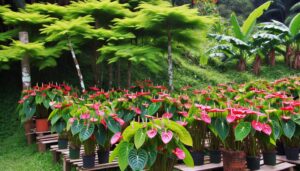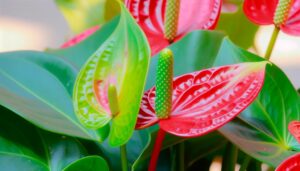What Is an Anthurium Plant? A Complete Care Guide!
Anthurium plants, native to Central and South American rainforests, symbolize hospitality and happiness. You’ll recognize their glossy, heart-shaped leaves and vibrant, waxy spathes.
Popular species like Anthurium andraeanum boast intricate leaf patterns. These plants thrive in bright, indirect light and well-draining soil with humidity levels between 60-80%.
Avoid root rot with balanced watering and regular care including pruning, pest monitoring, and bi-monthly high-phosphorus fertilization. For propagation, select a healthy stem, apply rooting hormone, and maintain consistent moisture and warmth.
Discover their dual ornamental and practical benefits, such as air-purifying qualities and preference for high humidity and indirect light.
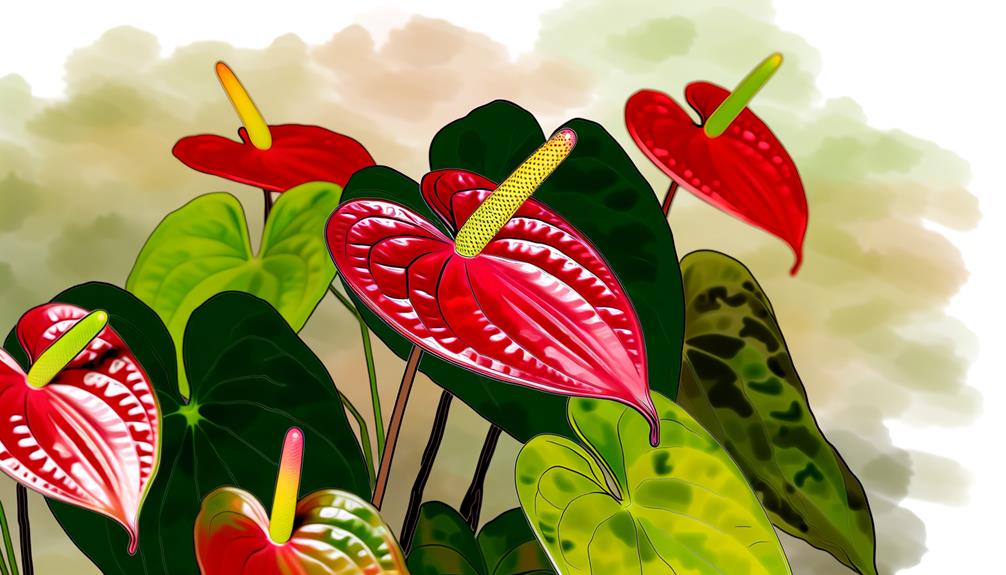
Key Takeaways
- Native to Central and South American tropical rainforests, symbolizing hospitality and happiness.
- Features glossy, heart-shaped leaves and vibrant, waxy spathes.
- Requires bright, indirect light, well-draining soil, and high humidity for optimal growth.
- Popular varieties include Anthurium andraeanum and Anthurium clarinervium, known for their unique ornamental appeal.
- Often used in floral arrangements and for their air-purifying qualities.
Origins and History
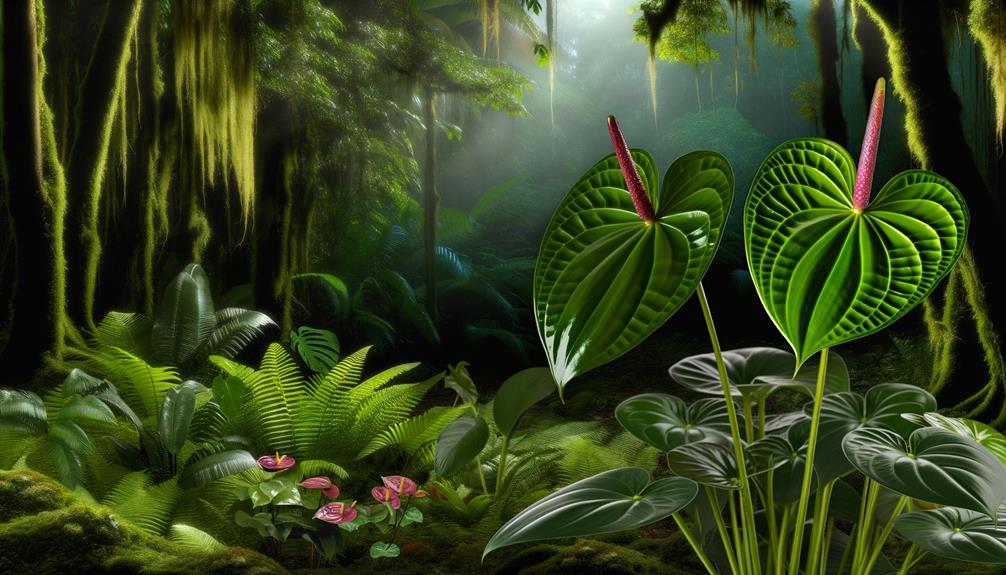
The anthurium plant’s origins trace back to the tropical rainforests of Central and South America, where its diverse species thrive under the dense canopy.
These regions provided the ideal conditions for historical cultivation, with rich soil and high humidity fostering growth.
The anthurium holds significant cultural importance, symbolizing hospitality and happiness in many cultures. Its vibrant, heart-shaped spathes made it a popular choice in floral arrangements, boosting its global trade.
European explorers first documented anthuriums in the 19th century, leading to their introduction to international markets.
Physical Characteristics
Anthurium plants display distinct physical characteristics, like glossy, heart-shaped leaves and colorful, waxy spathes that are vital for both photosynthesis and reproduction. The leaf consistency is typically sleek and tough, adding to its durability and capacity to hold moisture.
You’ll observe that the spathes, often confused for blooms, exhibit vibrant hues such as crimson, rose, or ivory, which allure pollinators. The real blooms are small and grouped on the spadix, a spike that emerges from the spathe. This configuration maximizes pollination effectiveness.
When nurturing anthuriums, make certain they receive indirect sunlight and maintain high humidity levels to uphold their luxurious leaf consistency and vivid spathes. Regular spraying and well-draining soil mixture additionally boost their development.
Common Varieties
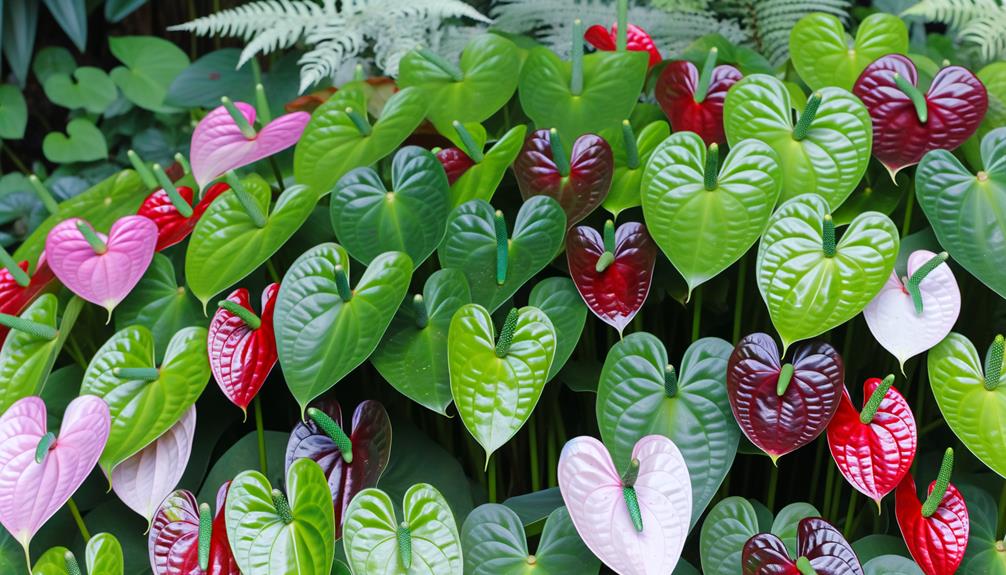
You’ll find Anthurium species like Anthurium andraeanum and Anthurium clarinervium are popular choices due to their vibrant spathes and intricate leaf patterns.
With varieties boasting hues from deep reds to pastel pinks, color selection is essential for aesthetic cultivation.
Focus on the unique leaf shapes, as proper pruning and care can enhance the plant’s ornamental appeal.
Popular Anthurium Species
Exploring the diverse world of popular Anthurium species, you’ll encounter striking varieties like Anthurium andraeanum, known for its vibrant spathes, and Anthurium crystallinum, admired for its velvety, veined foliage.
Anthurium andraeanum, often referred to as the Flamingo Flower, thrives in blooming seasons that span most of the year. Special hybrids of this species enhance both indoor decoration and outdoor landscaping with their unique colors and forms.
Anthurium crystallinum, with its stunning leaf patterns, demands higher humidity for ideal growth, making it perfect for indoor terrariums.
Cultivating these species involves maintaining moderate light, well-draining soil, and consistent moisture, ensuring they remain lush and vibrant, whether adorning your living room or enhancing your garden.
Colorful Flower Varieties
Many Anthurium flower varieties charm with their vibrant shades, ranging from deep reds and pinks to striking whites and greens, each bringing a unique aesthetic to your botanical collection.
The ‘Anthurium andraeanum’ showcases vivid blossoms that exude tropical beauty with its glossy, heart-shaped spathes and yellow spadices.
‘Anthurium scherzerianum’, another distinct plant, features coiled spadices and exotic colors, primarily in red and orange hues.
For a blend of subtlety and elegance, the ‘Anthurium crystallinum’ offers white spathes that contrast beautifully with its dark green leaves.
Cultivating these varieties requires bright, indirect light, high humidity, and well-draining soil. Regular misting and avoiding waterlogged conditions will ensure your Anthuriums thrive and maintain their vivid, enchanting hues.
Unique Leaf Shapes
When examining Anthurium varieties, you’ll notice that their unique leaf shapes, such as the elongated, velvety leaves of Anthurium clarinervium, add a distinctive visual interest to any plant collection. Anthuriums exhibit a fascinating array of leaf colors, leaf sizes, leaf textures, and leaf patterns.
For example, Anthurium crystallinum has large, heart-shaped leaves with striking white veining, while Anthurium magnificum features dark green, leathery leaves.
| Variety | Leaf Shape | Attributes |
|---|---|---|
| Anthurium clarinervium | Elongated, velvety | Deep green with prominent white veins |
| Anthurium crystallinum | Heart-shaped | Large leaves, striking white veins |
| Anthurium magnificum | Broad, leathery | Dark green, prominent veining |
| Anthurium andraeanum | Paddle-shaped | Glossy green, sometimes with a red tinge |
Ideal Growing Conditions
To achieve the best growth for your Anthurium plant, ensure it’s placed in a location with bright, indirect light. Direct sunlight can scorch the leaves, while insufficient light reduces flowering.
Balance your watering frequency; the soil should remain moist but not waterlogged. Utilize a well-draining soil type, such as a mix of orchid bark, perlite, and peat moss, to prevent root rot.
Humidity levels are essential, as Anthuriums thrive in environments with 60-80% humidity. Consider using a humidifier or placing a water tray nearby to maintain ideal conditions.
Care and Maintenance
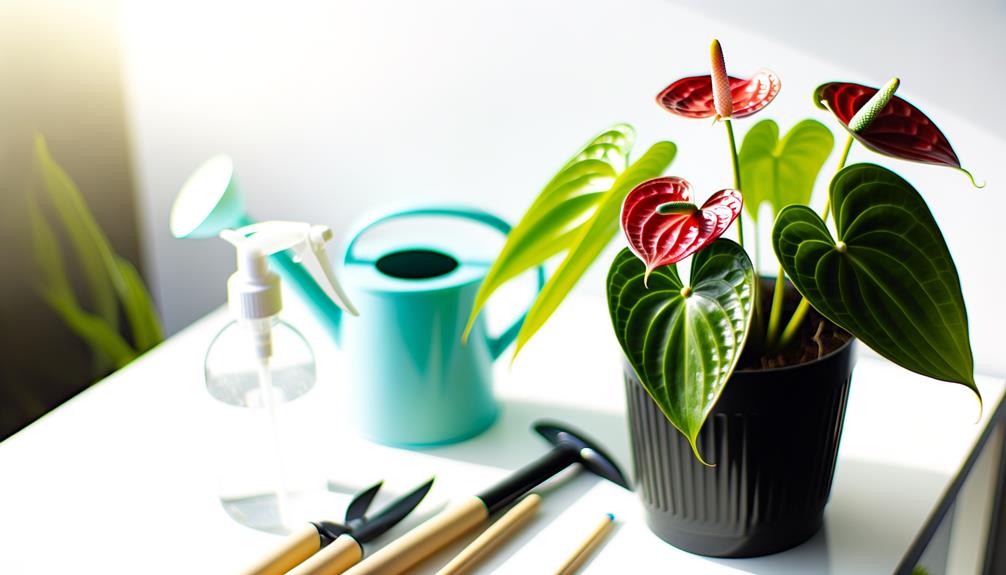
Consistent care and maintenance of your Anthurium plant involve regular pruning, monitoring for pests, and ensuring nutrient-rich feeding.
Adjust the watering frequency to keep the soil moist but not waterlogged; overwatering can lead to root rot. Employ precise pruning techniques, removing dead or yellowing leaves to promote air circulation and plant health.
For ideal growth, apply balanced fertilizing methods bi-monthly using a high-phosphorus fertilizer. This supports vibrant blooms and robust foliage.
Vigilantly inspect your plant for common pests like aphids and spider mites, utilizing organic pest control solutions such as neem oil when necessary.
Propagation Methods
When propagating your Anthurium, you’ll find several effective methods at your disposal.
Seed germination, division of roots, and stem cuttings each offer unique benefits and challenges.
Seed Germination Technique
Germinating Anthurium seeds requires careful attention to moisture, temperature, and light conditions to guarantee successful propagation. Maintain water temperature between 75-85°F to maximize germination.
Light exposure should be bright but indirect to prevent seedling damage. For soil composition, use a well-draining mix rich in organic matter. Keep humidity levels around 80% to foster seedling growth.
| Factor | Ideal Condition | Notes |
|---|---|---|
| Water Temperature | 75-85°F | Use a heating mat if needed |
| Light Exposure | Bright, Indirect | Avoid direct sunlight |
| Soil Composition | Well-draining, Organic | Enhances root development |
| Humidity Levels | Around 80% | Use a humidity dome |
Monitor these parameters closely for best results.
Division of Roots
After successfully germinating the seeds, another effective propagation method for Anthurium plants involves the division of roots. Carefully remove the plant from its pot, exposing the root structure.
Gently separate the roots, ensuring each section has healthy root growth and at least one stem. This method promotes efficient nutrient absorption and water uptake. It’s critical to use sterilized tools to prevent infection.
Replant each division in a well-draining potting mix, maintaining consistent moisture levels to support new growth. Monitor for signs of stress, such as wilting or yellowing leaves, indicating issues in root establishment.
Stem Cuttings Process
Using stem cuttings for Anthurium propagation involves selecting a healthy stem with at least two nodes, providing ideal conditions for root development and growth. Start by applying a rooting hormone to the cut end to stimulate root production.
Prepare a well-draining soil mixture, preferably containing perlite, peat moss, and orchid bark. Maintain a consistent watering schedule to keep the soil moist but not waterlogged.
Place the cutting in a warm environment with temperature requirements between 70-85°F (21-29°C) to promote best growth. Ensure the cutting receives indirect sunlight to avoid leaf burn.
Regularly monitor for root development, adjusting the watering schedule as necessary to prevent fungal infections. Following these detailed steps will enhance the success rate of your Anthurium propagation.
Symbolism and Uses
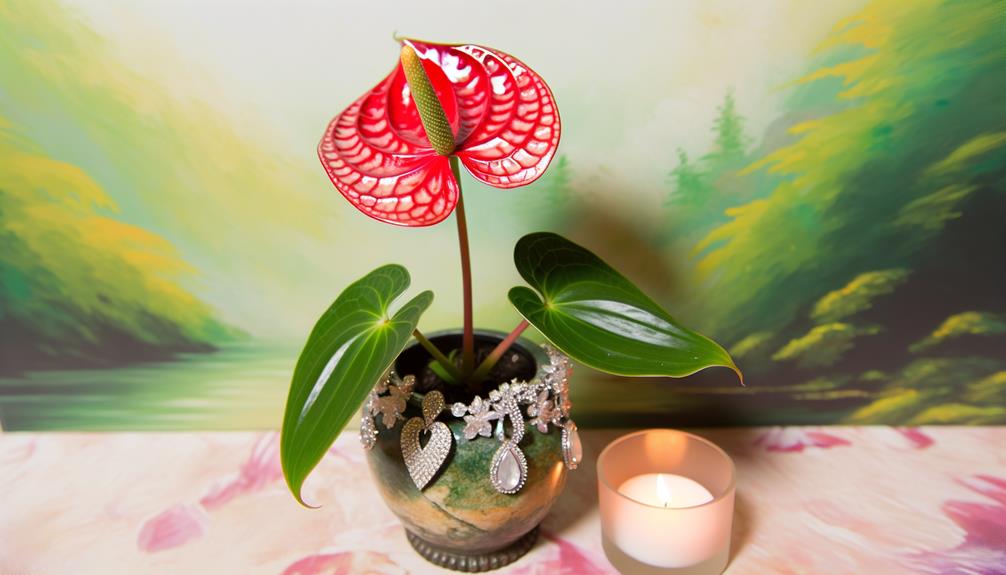
The anthurium plant, often associated with hospitality and abundance, serves both ornamental and practical purposes in various horticultural practices. Its symbolism extends to cultural significance in many societies, where it’s seen as a token of warmth and welcome.
You’ll find its striking red spathes and glossy leaves commonly used in floral arrangements to signify love and friendship.
In terms of practical uses, the anthurium plant is prized for its air-purifying qualities, making it a valuable addition to indoor environments. Cultivating this plant requires understanding its preference for high humidity and indirect light.
Watering should be done when the top inch of soil feels dry, ensuring the roots don’t get waterlogged. Regular feeding with a balanced fertilizer supports robust growth.
Conclusion
Tending to an anthurium isn’t just plant care; it’s cultivating a slice of tropical paradise. You’ll marvel at its glossy leaves and vibrant spathes, each one a tribute to nature’s artistry.
With the right light, humidity, and love, your anthurium will flourish, becoming a verdant gem in your collection.
Remember, propagation is your gateway to sharing this beauty. In your hands, anthuriums aren’t just plants – they’re a living heritage of botanical splendor.



